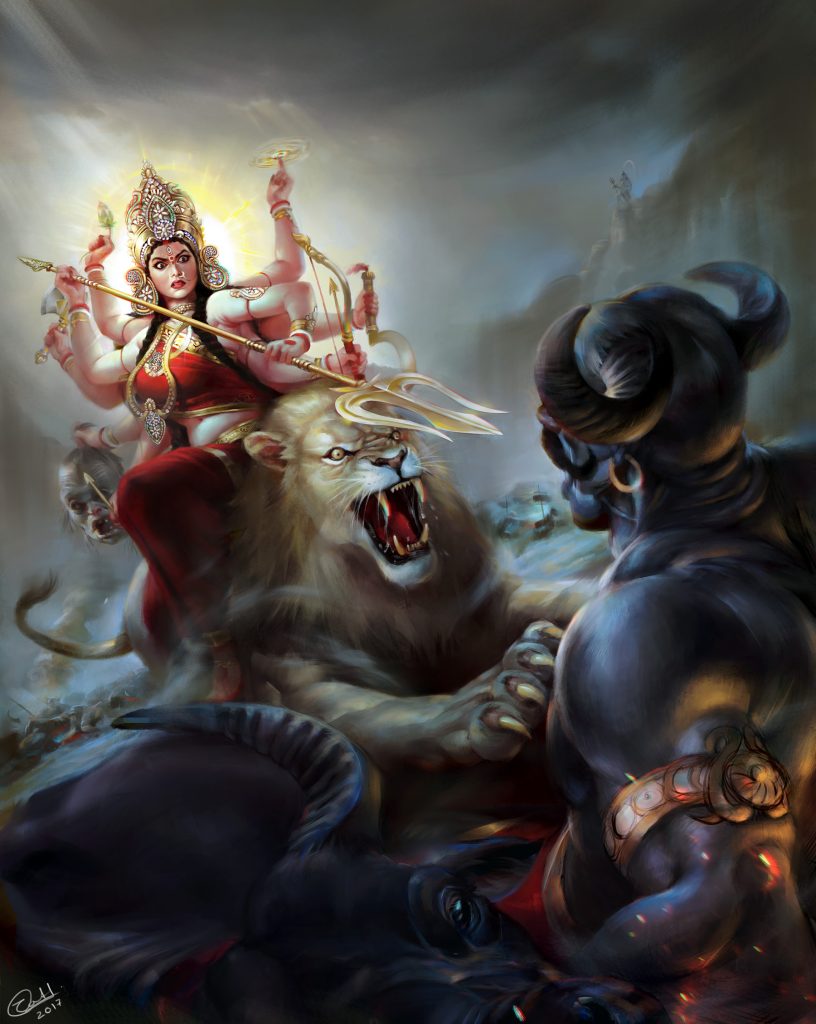Read the previous part here…
Seeing Mahishasura fall, the entire legions of the asura armies perished. The devas celebrated and showered flowers on Devi Chandika, and sang praises in her name. The Devi, the mother of the worlds, had brought an end to the tyranny of the all-powerful leader of the asuras.

The Devi Mahatmyam is an allegory – a tale with a deeper meaning. The first carita described the victory over mala, and over tamas. The second carita describes the fallacies of the mind – vikshepa shakti. The mind has a tendency to be restless – to constantly keep thinking of hundreds of things at once. Even when you sit still, the mind is never still. It keeps making up stories, analyzing imaginary scenarios, depending into daydreaming….The whole process of yoga is aimed at calming this restless mind. Asanas serve no greater purpose than enabling the sādhakā to sit still for extended periods of time, so that he can work on taming the mind.
Those who keep twisting themselves into pretzels in the name of yoga, mostly fail to grasp this basic concept, and unfortunately remain disconnected from the science of yoga, and execute a fine exercise routine instead.
While the first carita dealt with tamo guna, the second deals with rajo guna. Grey, black and generally dark colors dominate the first episode (Kali rupa) while red dominates the second. Red is the color of activity, of rajas. It is said that tamas is at the lower end, sattva is closer to the higher consciousness, and rajas is the bridge.
A positive manifestation of rajas helps you to fulfill the right desires of dharma, artha and kama, and sets you on the road to sattva and towards higher realization. A negative manifestation of rajas leads you to excessively indulge in artha and kama, and leads you to darkness, or tamas.
Adi Sankara, in his extensive commentaries on the Upanishads, has indicated that the devas denote the functioning of the indriyas, or senses (Surya – eyes, Indra – hands, Agni – speech etc..). Excessive negative rajas leads to hijacking these senses to satisfy negative urges (the asura in us), rather than using them to uplift our consciousness. The battle between the devas and asuras was said to last a hundred years, which denotes the human lifespan. Like when Mahishasura won, rajas takes over our senses and we spend our whole lives trying to bring them back under the control of the devas. That is the goal of yoga…
The battle is described in great detail. The names of the generals are colorful, and describe many aspects of negative rajas. Durdhara means irresistible, which denotes desire, and Durmukha means abusive, and denotes anger. It is only after these two are subdued (killed) that one can tackle Mahishasura.
The great asura proves to be a worthy match. So do our desires and our wants. His behavior embodies rajas – restlessness, desire, rage and excessive passion. We try to bring them under control, not once, not twice, but throughout or lives. We also achieve victories, albeit temporarily. Just like that diet that helped us lose weight, for a few months only. We slip back into our tendencies. And so getting rid of negative rajas is like fighting Mahishasura – he keeps eluding the Devi, and keeps changing forms…until…
We also run away from our personal demons, try to lie to ourselves, try to protect our false images, until the spear of the Devi strikes us…until the penetrating light of knowledge hits us. And then there is no escape.
The Devi pins Mahishasura down, and as he finally emerges in his true form, she beheads him with her sword, which is a symbol of viveka, or discrimination – when one begins to distinguish the apparent from the real, the Maya from the truth.
Mala can be overcome by karma yoga, and vikshepa can be overcome by total surrender to God (upāsana), or Bhakti yoga.
ॐ देवी कालरात्र्यै नमः॥
Om Devi Kalaratryai Namah॥
या देवी सर्वभूतेषु माँ कालरात्रि रूपेण संस्थिता। नमस्तस्यै नमस्तस्यै नमस्तस्यै नमो नमः॥
Ya Devi Sarvabhuteshu Ma Kalaratri Rupena Samsthita।
Namastasyai Namastasyai Namastasyai Namo Namah॥
Well, we have understood how to overcome tamas, and rajas. Next is sattva. But wait – sattva is a good guna, so why should be work on overcoming sattva? What form does Devi take in the next (and final) carita? Who does she fight with? Read on, to know more:)
to be continued…

Pingback: A conversation with a messenger…
Pingback: The coming of Chamunda…